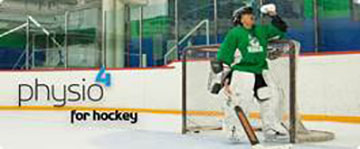
Hockey is truly Canada’s passion, NHL or no NHL. Before you (or your child) even step on to the ice make sure you are well equipped. Wear a mouth guard and a good quality helmet that fits you and is adjusted properly. Getting fitted with the right equipment will help prevent injury from muscle imbalance, flying pucks, body contact and accidental collisions.
If you feel pain during or after playing hockey, your physiotherapist can help.
Physiotherapist Keum Choi (Providence Health Care) has enjoyed playing recreational ice hockey for years without injury by following Physio-4 tips.
Hockey Tips to prevent injury, alleviate pain and keep you moving for life.
-
Prepare to play. A dynamic warm up has been shown to be a powerful factor in reducing injury. Start with 5 to 10 minutes of large muscle activity such as a few slow laps of the rink, stair climbing or some spins on a stationary bike.
-
Keep muscles in balance. Muscles used repetitively in hockey create large imbalances in strength and tightness. Stretch tight muscles and strengthen weak ones. You can reduce muscle strain by wearing properly fitted equipment, especially the helmet and shoulder pads. And, be sure that your stick is the right length.
-
Train your body for hockey. Hockey specific off-ice training exercises will improve control of your neck, spine and pelvis, and will help with skating, puck skills and safe body contact.
- Prevent giving or receiving a concussion. Always approach the boards on an angle not straight on. Avoid the danger zone by being on the boards or 3-4 feet away from them. Never check from behind or make suicide passes. If you get hurt, your physiotherapist can help you get back on the ice safely.
To contact a physiotherapist for an assessment to help you improve your pre and post game performance, visit movingforlife.ca.

